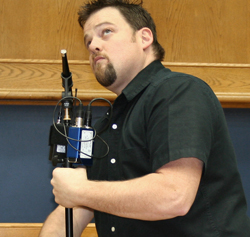Electret measurement microphones: an often-overlooked tool for the optimization of sound systems.
While it’s possible to spend thousands of dollars on laboratory quality measurement microphones, electret microphones are all well under $1,000, and a couple are under $100, though the old chestnut applies: you get what you pay for.
The better ones can also be used for a few sound reinforcement and recording applications where the advantages of directional polar response or contoured frequency response are not important, such as secondary close-mic’ing of DI’ed acoustic instruments or drum overheads.
In contrast with dynamic microphones, which employ the moving-coil principle of loudspeakers, the diaphragm in a condenser microphone acts as one plate of a capacitor. Sound vibrations alter the distance between diaphragm and back plate, shifting the capacitance, with an instantaneous change in voltage.
Electret condensers, invented at Bell Labs in the ’60s, employ a ferroelectric material with a permanent static charge, so they don’t require the bias voltage of a “true” condenser, and are referred to as “pre-polarized back electret condensers.”
Though they don’t utilize a bias voltage, their preamps require a voltage that’s usually derived from phantom power, but doesn’t need to be the full 48 volts required by “true” condensers. This voltage can be as low as 9 or 12 volts, though these lower voltages cause a loss of headroom – not a concern when employing standard phantom power found in most professional audio equipment.
Originally used for many low-cost and miniature applications, today’s electrets can rival the performance of high-end condensers at a fraction of the price.
Electret measurement microphones vary from $50 to $500 and the differences can be found in ruggedness, noise floor and consistency from one to the next, important when using an array of microphones to evaluate the performance of a sound system across a large listening area.
Some measurement systems allow the insertion of correction files to compensate for variation with less than perfectly matched microphones.
Sound system assessment can be accomplished more efficiently by deploying multiple measurement mics at once. There’s often limited time for measurement, so the ability to quickly compare response at many positions speeds the process.
Eight-channel Firewire microphone interfaces help array microphones across a listening area to determine an array’s performance and its interaction with side arrays, fills and other loudspeaker zones. Line array measurements along the X-axis help calculate compensation for long-throw HF loss, midrange coupling in an array’s center and nearfield gain adjustments.
Even if you aren’t measuring a line-array, deploying multiple microphones, both on-axis as well as in transition areas – where the coverage of one loudspeaker meets another – allows engineers to quickly optimize a traditional system by themselves in a fraction of the time required when moving one or two microphones around a venue.
Our Real World Gear photo gallery details the latest electret measurement microphones.




















